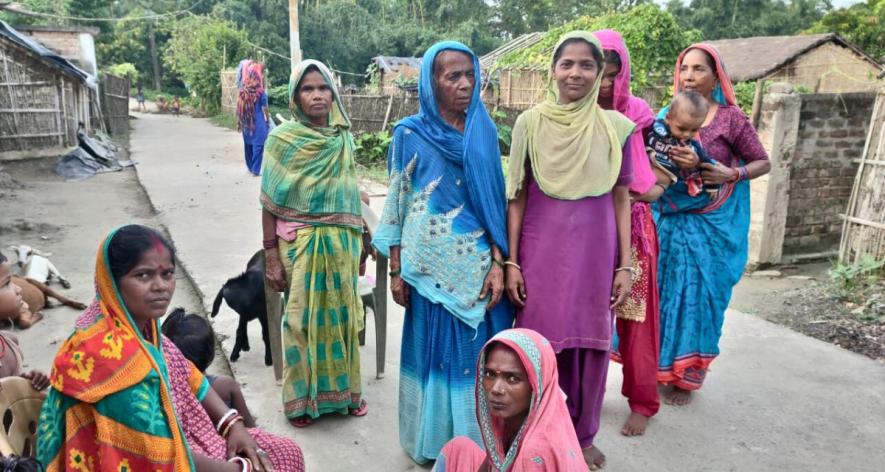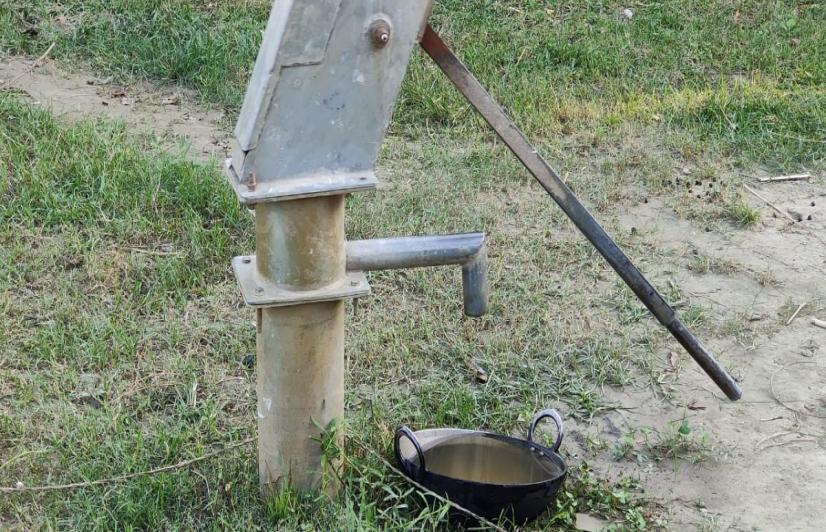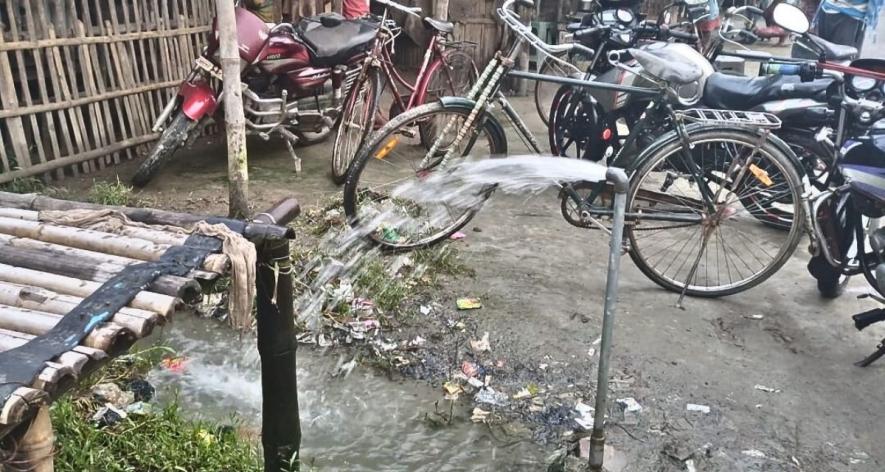Bihar: Ranked 'High Achiever' in Household tap Connection Coverage, Jamui District Forced to buy Drinking Water

Jamui, Bihar: Bablu Kumar (35) stays in the Railway Colony of Gangra village in Bihar's Jamui district. He buys drinking water at Rs 20 for a 20-litre bottle.
"We need at least two bottles a day. Of the 1,000 households in the colony, about 700 buy water while the rest draw drinking water from a hand pump. Work for the tap water scheme started in our ward in 2019, but it is still incomplete," said Bablu Kumar. Four concrete pillars on which a water storage tank was to be placed stand testimony to an unfulfilled dream of tap water supply in Ward No.1, where Bablu Kumar lives. The tank, pipeline connection to households and taps remain.
"I did not have the documents of the scheme under which the project came. Now that I have acquired them, we have complained to the officials about the incomplete work. Hopefully, the matter will be resolved soon," said Mahesh Majhi, a member of Ward No.1. A ward member is the official in charge at the ward level of implementing the Har Ghar Nal Ka Jal Yojana (HGNJY), the tap water supply scheme of Bihar.
In April this year, Jamui district, located on the Bihar-Jharkhand border, got an award in the half-yearly Jal Jeevan Survekshan-2023 (JJS) of the Department of Drinking Water and Sanitation under the Central Ministry of Jal Shakti. The district was ranked third in the "High Achievers" category, meaning it has achieved 75-100% tap water connections. This is second only to 'Frontrunners,' a category of districts with 100% connections. The state Public Health and Engineering Department (PHED) had put up a social media post on Facebook about the award on July 6.
The JJS ranking is based on indicators like the percentage of households receiving more than 55 litres of water/person/day, portability and regularity parameters, source sustainability, chlorination, user charges and grievance redressal system. The two components of the assessment are self-reporting by districts on these standards and vetting by an independent agency to check the functionality of tap water connections.
"Jamui falls in the category of aspirational districts — those defined by poor socio-economic indicators. Despite that, it performed well on the JJS. Hence, the award. However, if we compare with other districts in Bihar, not much work has happened in Jamui under the HGNJY scheme," said Ashok Kumar, Chief Engineer cum Special Secretary of the PHED department at Patna, the state capital.
HGNJY is Bihar's own scheme, separate from the Central government's Jal Jeevan Mission (JJM). It was launched on September 27, 2016, and promised a water supply thrice a day for two hours each. HGNJY aimed at providing tap connections to the whole state by March 2020. Until 2021, Bihar's HGNJY had achieved 152.16 lakh tap connections compared to 8.44 lakh connections under JJM and 2.32 lakh connections through the National Rural Drinking Water Programme. According to a source in the PHED, two lakh households still await connection.
Four km away from Ghangra is Patsanda village.
Sanjay Majhi (50) says that his locality, Musahari Tola, is home to about 1,500 people but is still not connected via HGNJY. They depend on two handpumps installed by the state government in 2015 for drinking water.

"The groundwater in Patsanda has high iron content, so the handpumps are useless. We have complained to the Mukhiya (village head) and government officials many times, but to no avail," said Majhi. Of the 13 wards in Patsanda, three are not yet connected to the scheme.
"But even in the wards that are connected, very few people drink tap water because it has not been filtered for years, and the taps are broken in many places. They only use it for washing clothes," said Sanjay Majhi.
"Biru Majhi, the ward member in Musahari Tola, went to jail on minor charges, and the work could not begin due to that," says Anjani Singh, the Mukhiya (head) of Patsanda village. Though the Mukhiya and Gram Panchayat can exert pressure on the ward members, nothing was done in the case of Musahari Tola.
Four years ago, Jamuni village in Chakai Panchayat of the district got an overhead water tank and taps in every household under HGNJY.
"A large amount was spent on the tank, pipelines and taps, but it has been a year since these taps dried up. We have lodged complaints to officers at all levels of the administration but to no avail," says Bharat Sharma, a resident of Jamuni.
Under the scheme, groundwater is extracted from a source near the village, and a reverse osmosis filtration system is installed over it. The filtered water is pumped to an overhead tank and piped to individual households.
"I don't see how Jamui's situation is better than any other district in Bihar. The scheme has either not reached villages, and wherever it has reached, the taps and pipelines are lying damaged or closed. One will hardly find any village where the HGNJY is running well," says Rahul Kumar, a resident of Jamui and a local journalist.
"In the whole of Bihar, in fact, water supplied from the HGNJY is only used for washing clothes. If the scheme was working well, people would not have had to buy drinking water," he says. Numerous water purification plants have mushroomed all over the state and are minting good money. Middle-income families can afford to buy water, but poor households have to depend on handpumps, added Kumar.
101Reporters found that even in villages connected with tap water under the scheme, either the pipeline is broken or the taps, leading to wastage of water.
"HGNJY is full of corruption. It is well-known that contractors use bad-quality pipes, and there is no coordination between them and the ward members in charge of implementing the scheme on the ground. Wherever work has actually happened, it has not been followed up efficiently," says Amlesh Jha, a Right to Information activist from Patna. In 2022, a news report published in the Hindi Daily Dainik Bhasker said 70% of the work done under the HGNJY in 10 blocks of Jamui is lying shut.
Scarce Groundwater Creates a Catch-22 Situation
Low groundwater level leads to contamination. Even as tap water supply is crucial in such areas, it is difficult to implement it there simultaneously because water is sourced from underground aquifers only. The state government's Minor Water Resources Department, which covers ponds and canals, says that Jamui is one of the five districts where groundwater is lowest. In 2020, water was available at 11.28 meters before the monsoon and 7.35 meters after the monsoon. Whereas in 2021, water was available at 9.9 meters before the monsoon and 6.03 meters after the monsoon. Also, Jamui is one of the 11 districts in Bihar with high fluoride content in groundwater.

"Arsenic is also being found in groundwater now," said Gyan Chandra Gyani, an environmentalist from the neighbouring district of Bhagalpur.
"Jamui is a hilly region. That's why the groundwater level there is low," said Chandra. There are 5-6 rivulets apart from Kiyul and Ulai, the main rivers in the district, but they mostly run dry apart from monsoon.
"Groundwater is used for agriculture apart from drinking water and other needs. In such circumstances, if the water under the HGNJY is wasted due to broken taps or pipes, it is a grave misuse of such a precious resource. The PHED department is doing an appreciable job in trying to provide drinking water to areas with high contamination, but they should look into this problem urgently and focus on an efficient filtration system," says Eklavya Prasad, founder of Megh Pyne Abhiyan, a non-profit working on water issues in Bihar, Jharkhand and West Bengal.
101Reporters called the District Development Council, Jamui, in charge of implementing HGNJY in the district, several times but did not get a response. An official from the Patna PHED office says on conditions of anonymity that till now, the HGNJY was being run by three agencies- PHED, Panchayati Raj and the Urban Development and Housing Department of the state.
"Lack of coordination between the three depa
rtments led to problems. There were also litigation issues between ward members and contractors that delayed the process. However, in May 2023, the state government decided to hand over the scheme entirely to PHED. Things should improve now," he says.
(Rahul Kumar Gaurav is a Bihar-based freelance journalist and a member of 101Reporters, a pan-India network of grassroots reporters.)
Get the latest reports & analysis with people's perspective on Protests, movements & deep analytical videos, discussions of the current affairs in your Telegram app. Subscribe to NewsClick's Telegram channel & get Real-Time updates on stories, as they get published on our website.
























